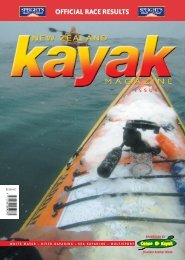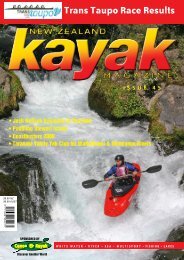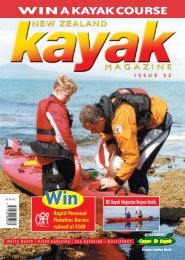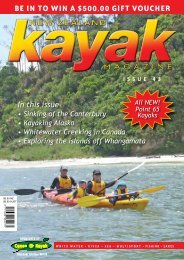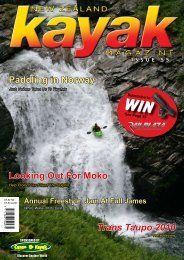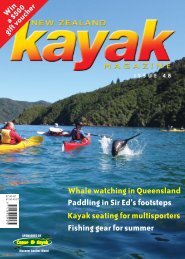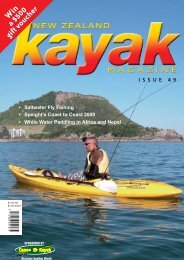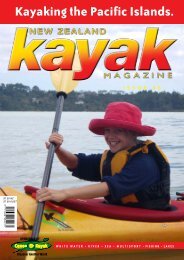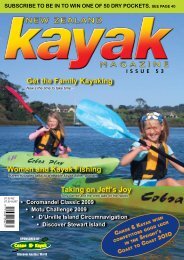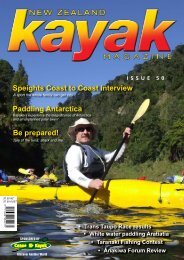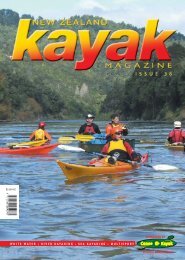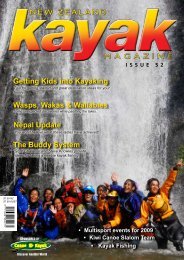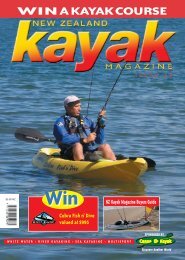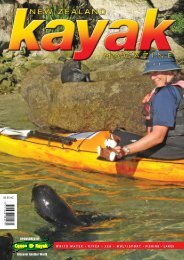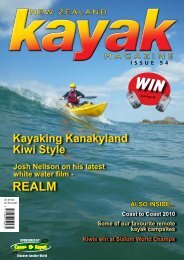C&K mag #34 dps-f spg - Canoe & Kayak
C&K mag #34 dps-f spg - Canoe & Kayak
C&K mag #34 dps-f spg - Canoe & Kayak
Create successful ePaper yourself
Turn your PDF publications into a flip-book with our unique Google optimized e-Paper software.
SAFETY<br />
One Paddler’s Achilles<br />
An experienced kayaker paddling solo<br />
close to home capsizes unexpectedly<br />
and suffers a disabling injury. Floating<br />
alongside his kayak, he drifts<br />
and waits.<br />
On a calm July afternoon, Patrick Simard set out<br />
to paddle alone near his home in Victoria. Patrick<br />
is a skilled kayaker who likes to paddle for fitness.<br />
He has a good roll and has experience paddling<br />
and rolling a kayak in surf. He has taken a number<br />
of courses and clinics to keep abreast of effective<br />
paddling techniques and good judgment for seakayak<br />
touring, and over the past year, he’s<br />
concentrated on developing his offside roll.<br />
His plan was to launch from Cattle Point and cross<br />
Baynes Channel to paddle out to Strongtide and<br />
Chatham Islands. The air temperature was about<br />
70˚F, but the water was in the mid-50s, so under<br />
his PFD and spray skirt, he wore a 3mm wetsuit.<br />
The arms of the suit chafe a little, but Patrick puts<br />
up with it knowing that the sleeves of his suit will<br />
keep him warmer in the cold British Columbia<br />
water than a sleeveless Farmer John suit would<br />
in cold water.<br />
The wind was calm, and the sea was smooth.<br />
Visibility was more than a mile through light<br />
overcast. The marine forecast was for continued<br />
calm weather throughout the day. The flood tide,<br />
pushing eastward from the Pacific Ocean and<br />
through the Strait of Juan de Fuca at a speed of<br />
two knots, accelerated as it curled around the<br />
southern tip of Vancouver Island. The tidal stream<br />
at Baynes Channel, well-known for its strong<br />
currents, would be running at about four knots at<br />
its peak.<br />
Patrick launched from Cattle Point at 2:30 and<br />
headed along the Vancouver Island shore, then<br />
across Baynes Channel to Strongtide and Chatham<br />
Islands. The crossing was uneventful, and Patrick<br />
had only to make a small ferry angle to<br />
compensate for the current. After a short time<br />
exploring the shores of the islands, Patrick headed<br />
Originally published in the June 2005 issue of Sea <strong>Kayak</strong>er <strong>mag</strong>azine.<br />
Published here by permission of the editor www.seakayaker<strong>mag</strong>.com<br />
10 ISSUE THIRTYfour • 2005<br />
back across Baynes Channel. The tide was now<br />
flooding near its predicted maximum of four<br />
knots, and Patrick had adjusted his course to the<br />
west to make a good ferry angle that would set him<br />
on a course back toward Cattle Point.<br />
A sea-going tug crossed Patrick’s path, and he set<br />
up to surf its wake. The waves were only two feet<br />
tall and didn’t provide much of a ride. Patrick was<br />
relaxed and unconcerned about the tug’s wake.<br />
After it had passed, he noticed a larger wake<br />
closing in on him from a different direction. Three<br />
feet tall with a breaking crest, this wake promised<br />
a better ride. The tidal current probably<br />
contributed to the wave’s steep slopes and slightly<br />
breaking crest. The source of the wake was a<br />
mystery-possibly a large freighter out in the<br />
shipping lane.<br />
Before Patrick had time to set up for surfing, the<br />
wake hit him broadside on his right. Patrick let the<br />
crest pass beneath the kayak, but the back side of<br />
the wave was surprisingly steep. Patrick began to<br />
capsize down into the trough and prepared to<br />
high-brace into the trough as the kayak slid down<br />
the back of the wave. He had to reach well down<br />
with his paddle to reach the water. He capsized<br />
only far enough to dip his shoulder in the water;<br />
his brace kept him at the surface but didn’t right<br />
the kayak. After a quick sculling stroke to hold him<br />
at the surface, he put additional effort into a<br />
second attempt to high brace, but he lost his grip<br />
of the paddle from his right hand and capsized<br />
fully. Something had happened to his right arm.<br />
He released the spray deck and exited his kayak.<br />
He emerged and held onto his kayak with his left<br />
hand. His paddle was floating nearby, and as he<br />
reached for it, he realized that he had dislocated<br />
his right shoulder.<br />
While in the water, he assessed his situation: He<br />
could see the tug that had made the smaller wake<br />
heading away. A sailboat, the only other vessel in<br />
the area, was also heading away from him.<br />
Although his right shoulder was badly injured, it<br />
wasn’t very painful for the first few minutes;<br />
however, with the joint between his upper arm<br />
by Doug Alderson<br />
and shoulder now distorted, his arm and hand<br />
were weak and unresponsive.<br />
He tried to keep his injured limb very still. He held<br />
onto the boat with his left hand and held the<br />
paddle with his weakened right hand. The<br />
flooding tide was pushing Patrick out of Baynes<br />
Channel into the open waters of Haro Strait. He<br />
drifted in the current for about 15 minutes before<br />
he saw a sailboat under power approaching him<br />
from the northwest. With only one good arm, it<br />
was very difficult to hold onto the kayak and raise<br />
his paddle above the surface to signal for help,<br />
but fortunately the sailboat responded to his<br />
signal and altered course toward him. By the time<br />
the sailboat reached him, Patrick had drifted a<br />
mile or more from where he had capsized and was<br />
approaching the much-less-travelled waters<br />
bordering Haro Strait.<br />
The skipper of the sailboat put a boarding ladder<br />
over the side, and Patrick passed over his kayak’s<br />
bow line and began the difficult task of getting up<br />
on the first step of the ladder. He had been in the<br />
water for 30 minutes but was still comfortably<br />
warm, and although he was seriously disabled, he<br />
was not in excessive pain. With Patrick and his<br />
kayak aboard, the sailboat skipper headed to<br />
shore for the emergency medical treatment that<br />
Patrick needed.<br />
Patrick felt cold and began to shake. The pain of<br />
the dislocation increased rapidly, and his hand<br />
had grown numb. The sailboat’s small motor<br />
struggled to make progress against the current. It<br />
took another half hour before they made it to a<br />
marina in Oak Bay. At the dock, Patrick’s kayak was<br />
locked up securely before his rescuer drove him<br />
to a nearby hospital.



